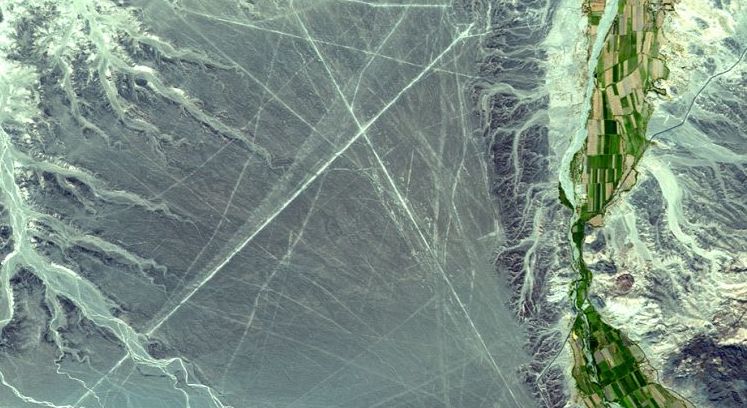October 2013
NascoBLOG 9

Image (c) NASA/GSFC/MITI/ERSDAC/JAROS, and U.S./Japan ASTER Science Team
Welcome to NascoBlog9. 23rd October 2013.
Continuing the theme of NascoBlog8, I said I would tell you how I deduced that virtually all the major features of the Nasca Lines were constructed to accord with celestial phenomena - cycles of the sun and the moon and align with certain first magnitude stars like Sirius, Vega, Arcturus, Capella and Rigel, just to name a few off the cuff. One must also not forget constellations like the Pleiades and Orion.
Many hypothesise that the Nasca Lines are a huge astronomical atlas whereby figurals, like the whale, the monkey, the hummingbird and the spider, for example, were designed to accord with certain constellations. However, when you have a zillion stars above your head you can 'draw' any shape you wish depending upon the degree of your imagination and beliefs.
In truth, as far as the Nasca Lines are concerned, we do not really know for sure which group of stars the builders may have used to represent a particular figural - and,of course, the reasons behind that selection. As an example, many believe the wonderful constellation Orion is depicted in the monkey geoglyph, but which culture laid out the monkey in the first place, and why?
It is now generally accepted that certain major lines which pass through figurals are without question aligned with extreme events like the Winter or Summer Solstice. However, in developing my own version of the 'Mandala', which I call a 'Geometriglyph', I was able to analyse virtually any line within the Nasca Lines palimpsest to determine whether it coincides with a particular celestial event.
There is no question whatever, the Nasca Lines are constructed to a celestial formulae based upon astronomical phenomena. By the same token: this discovery led to my derivation of the 'celestial constant' of 5.4545. (I will tell you about this constant next time). I was able to successfully analyse major and minor azimuths, rectangles and trapezoids, triangular geoglyphs, even the construction of individual figurals and zig-zag geoglyphs (Linear Observatories) and in almost every case hit a horizon target which correlated very closely with published astronomical tables.
After taking more than just a few hundred 'readings', I am still constantly amazed at the pin- point precision of this astronomical palimpsest. Bear in mind the Nasca Pampa is no smooth, flat blackboard as many visualise, but lines run arrow straight across 500 square kilometres of undulating, pebble strewn terrain scarred by rocky outcrops, dried up river beds, hollows and small hills.
I challenge any team today to produce even 20 square kilometres of 'Nasca Lines' based around a current Nascan sky scenario. Sorry, no modern survey tools, electronic assistance, or astronomy tables, etc. Oh, and you will need around a hundred years,or so, to verify your solar and lunar cycles, plus you have to rememember your star lines will move 1º after 72 years! Good Luck.
Sorry folks, my Media CEO tells me I have outrun my NascoBlog space today so I promise I will update you with 'Atlantis' news next time, as well as explaining more about the Geometriglyph and, of course, the built - in 'celestial constant'.
See you again with NascoBlog10 on the 6th November 2013
Don't forget, the more NascoBlogs you read, the more you will want a copy of "Portraits of the Gods", please just CLICK the ORDER BUTTON.
William James Veall
NascoBLOG 8

This image is into the public domain. Author Nharipra
Hello again everyone and welcome to NascoBlog8
I promised in NascoBlog7 to explain why in my opinion the now infamous archaeological monument called the Nasca Lines was constructed in accordance with astronomical phenomena - inspite of the fact that there is much opposition to this idea.
Anyone from their armchair at home can relatively easily 'google' many of the major lines spread across the Nasca palimpsest and discover which align with azimuths of solar, lunar or even first magnitude stars.
To help with research, Dr Anthony Aveni, Russell Colgate Professor of Astronomy and Anthropology, Colgate University, kindly sent me a copy of his excellent 'Astronomical Tables intended for use in Archaeoastronomy Studies: Aveni A, 1972. American Antiquity 37: 351- 540 ; these I have used countless times and I express my grateful thanks to Dr Aveni. I thoroughly recommend the tables to any budding Archaeoastronomer.
I also have to thank for assistance, in those far off, early days of my investigation into the Nasca Lines, Dr Ana Maria Cogorno, Albacea de Maria Reiche, Lineas y Geoglyphs de Palpa y Nasca, who helped me to locate a relatively unknown Geoglyph nestling in the Andean foothills and which overlooks the Nasca Lines. Quaintly referred to as the 'Mandela' this geoglyph provided the basis of my own interpretation which I subsequently termed, a 'Geometriglyph'.
Instead of posting a photograph, I have only quoted its co-ordinates so that you can interact with my NascoBlog8 by 'googling' to the site. You must, by the way, have a version of Google Earth installed. The co-ordinates for the 'Mandela' are Latitude 14º 38'' 38' S and Longtitude 75º 10'' 16'' W.
Since being brought to the notice of the scientific fraternity the 'Mandala' has gradually become recognised by a few as an essential ingredient of pre-Columbian Peru's astronomical pre-history. More especially because of its closeness to and therefore suspected astronomical relationship with the Nasca Lines.
In my opinion the two are directly related and in the next Nascoblog9 I will explain the reasons. Meantime, please, do have a look at the 'Mandela'. If by chance you do not have Google Earth installed on your computer you can log on to http://www.google.co.uk/earth/index.html where you have access to the original Geometriglyph story.
See you all again on the 23rd October 2013 for NascoBlog9 where I will also give you some really exciting news in respect of the 'Atlantis' story we ran in NascoBlogs 1 - 7.
To Order your copy of "Portraits of the Gods" simply Click the ORDER BUTTON .
Thank you and Enjoy.
William James Veall